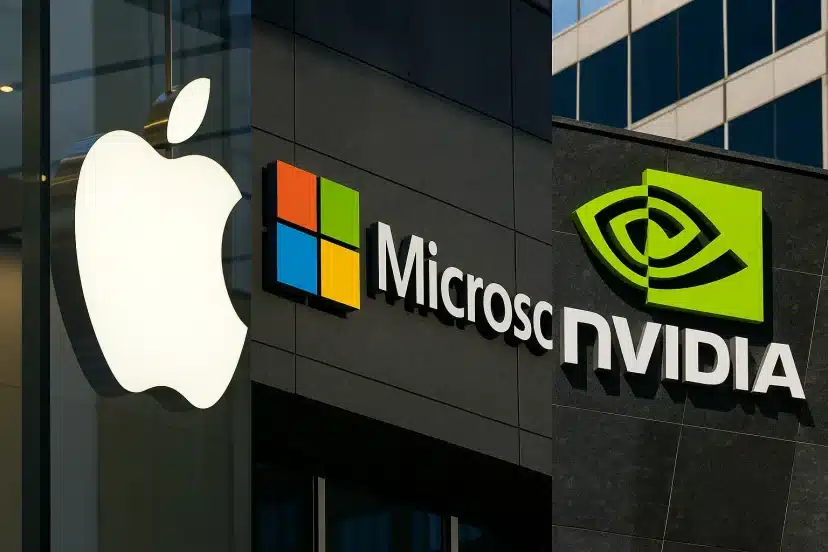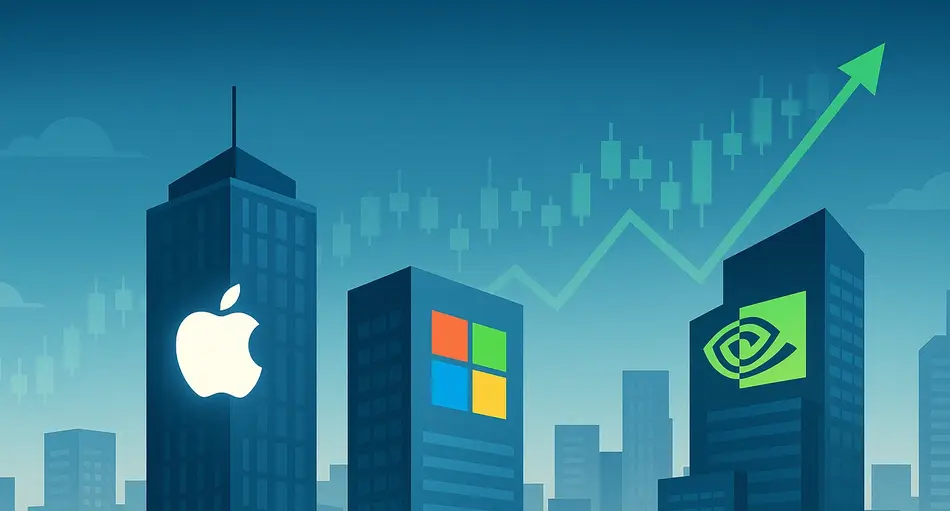Tech Stocks Driving S&P 500 Gains are once again outpacing the broader market, with the technology sector heading toward what could be its 11th year of outperformance in the past 12. Few stories in financial history rival the sustained dominance of Big Tech over the past decade. For investors, the pattern has become familiar: a small cluster of companies adding trillions in value while the rest of the market struggles to keep up.
Today, the conversation is as much about history as it is about the future. Looking back at August 19, 2020, Apple became the first company to reach a $2 trillion market capitalization — a milestone that not only reshaped investor psychology but also signaled a new phase of concentration in global equity markets.
Table of Contents
Apple’s $2 Trillion Moment: A Symbol of Tech Stocks Driving S&P 500 Gains
In 2018, Apple reached $1 trillion in market value after decades of product innovation and consumer devotion. But what stunned Wall Street was how quickly the company doubled that figure. In just two years, and during a global pandemic, Apple added another trillion dollars, hitting $2 trillion on August 19, 2020.
It took Apple nearly 38 years to climb to $1 trillion. The second trillion? Barely 24 months.
Part of the story was Apple’s resilience amid COVID-19 disruptions. While traditional sectors struggled, consumers relied on iPhones, Macs, and iPads to stay connected. At the same time, Apple accelerated its push into services like iCloud, Apple Music, and the App Store, building a recurring revenue engine that investors saw as more stable than hardware sales alone.
CEO Tim Cook was credited for steady leadership and deft management, transforming Apple from a hardware company into an ecosystem business.
On that same day in 2020, Apple’s market cap was nearly equal to the entire Russell 2000 small-cap index — thousands of companies combined. The symbolism was striking: one company rivaling the collective value of America’s smaller businesses.
And the rally wasn’t broad-based. Just six companies — Apple, Microsoft, Amazon, Alphabet (Google), Facebook, and Tesla — accounted for nearly all of the S&P 500’s gains in 2020, while the rest of the index was negative.
Hire the Talent Powering Tech’s Next Boom
Post your job on WhatJobs and connect with engineers, developers, and innovators who can help your company grow like Apple, Microsoft, and Nvidia.
Post a Job Now →2025: Déjà Vu All Over Again
Fast forward five years, and the story feels familiar — but the numbers are even bigger.
- Apple now trades at a valuation above $3 trillion.
- Microsoft has also crossed the $3 trillion mark.
- Nvidia has become the breakout star, soaring past $4 trillion in market cap on the back of unprecedented demand for its AI chips.
Once again, a small group of technology firms is shouldering the market. Just five stocks have driven more than half of the S&P 500’s 2025 gains, adding nearly 300 points of the 500-point advance in the index so far this year.
For some, the extreme concentration recalls the late-1990s dot-com bubble, when a narrow set of internet stocks dominated investor attention. But this time, analysts note, the fundamentals look stronger. Unlike many dot-com darlings, today’s tech leaders are enormously profitable, with balance sheets larger than most countries’ GDPs.

Why This Rally Feels Different
Skeptics point to the risks of relying so heavily on a handful of companies. If Apple, Microsoft, or Nvidia were to stumble, the ripple effects across the S&P 500 would be immediate and severe.
But optimists argue the comparison to 1999 is flawed. Back then, valuations were inflated on hype and future promise. Today, the tech leaders are delivering both growth and profits:
- Apple’s services business now generates over $100 billion annually, complementing iPhone sales.
- Microsoft dominates cloud computing with Azure, securing contracts with governments and corporations worldwide.
- Nvidia controls more than 80% of the AI accelerator chip market, making it the linchpin of the artificial intelligence boom.
In short, these are not speculative startups — they are the engines of the digital economy.
Market Concentration: A Double-Edged Sword
Even so, the concentration has its risks. The S&P 500, once considered a broad measure of the U.S. economy, now reflects the performance of just a few trillion-dollar giants.
Consider this:
- In 2020, six companies drove nearly all the S&P’s gains.
- In 2025, five companies are doing the same.
That leaves 495 other companies whose performance has little impact on the headline index.
This narrow leadership makes the market vulnerable. Any stumble in AI demand, regulatory crackdown, or shift in consumer behavior could send shockwaves through portfolios worldwide.
Investors Are Watching the Playbook
Wall Street remains divided. Some strategists warn that current valuations assume uninterrupted growth in AI, cloud, and digital services — expectations that may prove too optimistic. Others believe these companies are still in the early innings of reshaping global commerce and technology.
The difference between 1999 and 2025 may come down to earnings. In the late 1990s, profit growth lagged far behind soaring valuations. Today, Apple, Microsoft, and Nvidia are not only growing earnings but also driving the majority of profit expansion for the S&P 500 as a whole.
Build Your Career in the Companies Shaping the Future
Search WhatJobs for roles in AI, cloud, and digital services—find opportunities with the innovators driving global growth in 2025.
Search Jobs Now →Looking Ahead
Whether the current pullback is a mere “bump in the road” or a sign of deeper trouble, one thing is clear: the trajectory of the U.S. stock market is firmly tied to the fate of its technology titans.
History suggests that moments like Apple’s $2 trillion breakthrough in 2020 were not flukes but turning points. In 2025, with Apple at $3 trillion, Microsoft alongside it, and Nvidia past $4 trillion, the dominance of Big Tech has never been greater.
For investors, the question isn’t whether technology will lead. It’s whether anyone else can catch up.
FAQs
1. Why is the stock market rally concentrated in just a few tech firms?
Because these firms dominate both innovation and profitability. Their global reach in smartphones, cloud computing, and AI positions them as indispensable. Other sectors simply can’t match their scale or growth pace.
2. How does today’s concentration compare to the dot-com bubble?
The late-1990s saw soaring valuations without earnings. Today’s mega-caps combine high valuations with enormous profits. While risks remain, the fundamentals are stronger than in 1999.
3. Why was Apple’s $2 trillion milestone in 2020 so important?
It symbolized the shift of Big Tech into the core of the global economy. Apple’s second trillion took just two years, compared to 38 for the first — a sign of accelerating investor confidence and industry dominance.
4. Could this be a bubble?
Some fear bubble-like dynamics given the reliance on just a handful of stocks. But unlike the dot-com era, these companies produce massive cash flow and dominate key industries. Many investors see recent dips as entry points, not exit signals.




